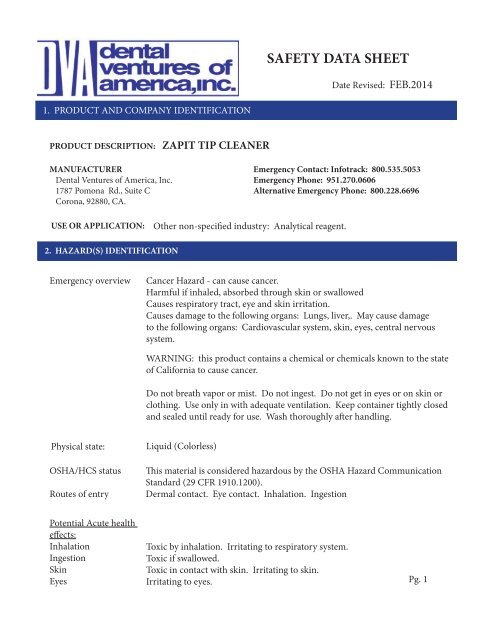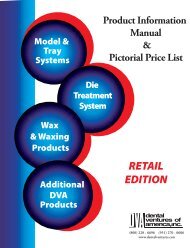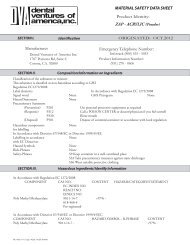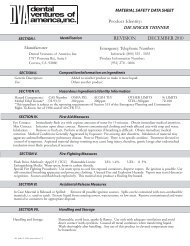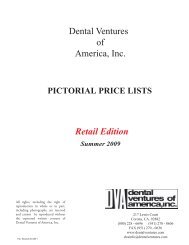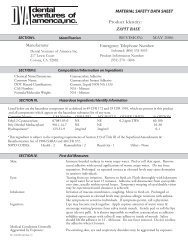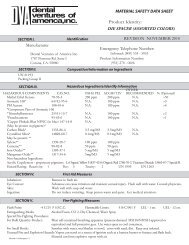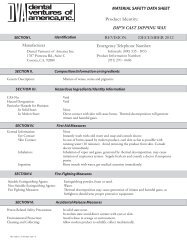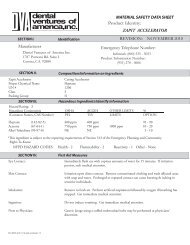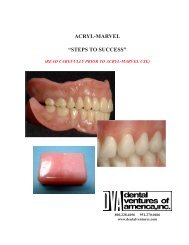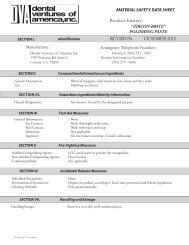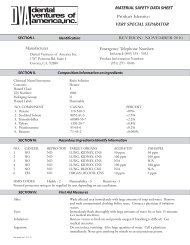zapit tip cleaner 2.11 pg.1.ai - Dental Ventures
zapit tip cleaner 2.11 pg.1.ai - Dental Ventures
zapit tip cleaner 2.11 pg.1.ai - Dental Ventures
Create successful ePaper yourself
Turn your PDF publications into a flip-book with our unique Google optimized e-Paper software.
SAFETY DATA SHEET<br />
Date Revised: FEB.2014<br />
1. PRODUCT AND COMPANY IDENTIFICATION<br />
PRODUCT DESCRIPTION: ZAPIT TIP CLEANER<br />
MANUFACTURER Emergency Contact: Infotrack: 800.535.5053<br />
<strong>Dental</strong> <strong>Ventures</strong> of America, Inc. Emergency Phone: 951.270.0606<br />
1787 Pomona Rd., Suite C Alternative Emergency Phone: 800.228.6696<br />
Corona, 92880, CA.<br />
USE OR APPLICATION:<br />
Other non-specified industry: Analytical reagent.<br />
2. HAZARD(S) IDENTIFICATION<br />
Emergency overview<br />
Cancer Hazard - can cause cancer.<br />
Harmful if inhaled, absorbed through skin or swallowed<br />
Causes respiratory tract, eye and skin irritation.<br />
Causes damage to the following organs: Lungs, liver,. May cause damage<br />
to the following organs: Cardiovascular system, skin, eyes, central nervous<br />
system.<br />
WARNING: this product contains a chemical or chemicals known to the state<br />
of California to cause cancer.<br />
Do not breath vapor or mist. Do not ingest. Do not get in eyes or on skin or<br />
clothing. Use only in with adequate ventilation. Keep container tightly closed<br />
and sealed until ready for use. Wash thoroughly after handling.<br />
Physical state:<br />
OSHA/HCS status<br />
Routes of entry<br />
Liquid (Colorless)<br />
This material is considered hazardous by the OSHA Hazard Communication<br />
Standard (29 CFR 1910.1200).<br />
Dermal contact. Eye contact. Inhalation. Ingestion<br />
Potential Acute health<br />
effects:<br />
Inhalation<br />
Ingestion<br />
Skin<br />
Eyes<br />
Toxic by inhalation. Irritating to respiratory system.<br />
Toxic if swallowed.<br />
Toxic in contact with skin. Irritating to skin.<br />
Irritating to eyes. Pg. 1
Potential chronic health<br />
effects:<br />
Carcinogenicity<br />
Mutagenicity<br />
Teratogenicity<br />
Developmental<br />
Fertility effects<br />
Target organs<br />
SAFETY DATA SHEET<br />
ZAPIT TIP CLEANER<br />
Can cause cancer. Risk of cancer depends on duration and level of exposure.<br />
No known significant effects or critical hazards.<br />
No known significant effects or critical hazards.<br />
No known significant effects or critical hazards.<br />
No known significant effects or critical hazards.<br />
Causes damage to the following organs: lungs, liver.<br />
May cause damage to the following organs: cardiovascular system, skin, eyes, central<br />
nervous system (CNS).<br />
Medical conditions<br />
aggravated by overexposure:<br />
Pre-existing disorders involving any target organs mentioned in this MSDS as being<br />
at risk maybe aggravated by over-exposure to this product.<br />
3. COMPOSITION /INFORMATION ON INGREDIENTS<br />
Under GHS-OSHA 4.11 the precise composition of this product is withheld as confidential business information<br />
(CBI). A more complete disclosure can be provided to a health, or safety professional when necessary.<br />
SUBSTANCES or MIXTURE<br />
NO. COMPONENT CAS.NO PERCENT<br />
Dichloromethane 75-09-2 100%<br />
4. FIRST-AID MEASURES<br />
EYES:<br />
SKIN:<br />
INHALATION:<br />
INGESTION:<br />
SIGNS AND SYMPTOMS<br />
OF OVER EXPOSURE:<br />
Check for and remove any contact lenses. Immediately flush eyes with<br />
plenty of water for at least 15 minutes, occasionally lifting the upper and<br />
lower eyelids. Get medical attention immediately.<br />
In case of contact immediately flush skin with plenty of water for at least 15<br />
minutes while removing contaminated clothing and shoes. Wash clothing<br />
before reuse. Clean shoes thoroughly before reuse. Get medical attention<br />
immediately.<br />
Move exposed person to fresh air. If not breathing, if breathing is irregular<br />
or if respiratory arrest occurs, provide artificial respiration or oxygen by<br />
trained personnel. Loosen tight clothing such as a collar, tie, belt or waisband.<br />
Get medical attention<br />
Wash out mouth with water. Do not induce vomiting unless directed to do<br />
so by medical personnel. Never give anything by mouth to an unconscious<br />
person. Get medical attention immediately.<br />
None known. Pg. 2
SAFETY DATA SHEET<br />
ZAPIT TIP CLEANER<br />
5. FIRE-FIGHTING MEASURES<br />
FLAMMABILITY OF THE PRODUCT:<br />
EXTINGUISHING MEDIA:<br />
In a fire or if heated, a pressure increase will occur and the<br />
container may burst.<br />
Use an extinguishing agent suitable for surrounding fire.<br />
EXTINGUISHING MEDIA NOT SUITABLE: None<br />
FIRE FIGHTING EQUIPMENT:<br />
Fire-fighters should wear appropriate protective equipment and<br />
self-contained breathing apparatus (SCBA) with a full face-piece<br />
operated in positive pressure mode.<br />
HAZARDOUS DECOMPOSITION PRODUCTS: Decomposition products may include the following materials:<br />
Carbon dioxide, carbon monoxide, halogenated compounds, car<br />
bonyl halides.<br />
SPECIAL EXPOSURE HAZARDS:<br />
6. ACCIDENTAL RELEASE MEASURES<br />
Promptly isolate the scene by removing all persons from the<br />
vicinity of the incident if there is a fire. No action shall be taken<br />
involving any personal risk or without suitable training.<br />
PERSONAL PRECAUTIONS:<br />
ENVIRONMENTAL PRECAUTIONS:<br />
No action shall be taken involving any personal risk or without<br />
suitable training. Evacuate surrounding areas. Keep unnecessary<br />
and unprotected personnel from entering. Do not touch or<br />
walk through spilled materials. Do not breathe vapor or mist.<br />
Provide adequate ventilation. Wear appropriate respirator when<br />
ventilation is inadequate. Put on appropriate personal protective<br />
equipment (see Section 8).<br />
Avoid dispersal of spilled material and runoff and contact with<br />
soil, waterways, drains and sewers. Inform the relevant authorities<br />
if the product has caused environmental pollution (sewers,<br />
waterways, soil or air).<br />
METHODS FOR CLEAN-UP SPILL:<br />
Stop leak if without risk. Move containers from spill area. Approach<br />
release from upwind. Prevent entry into sewers, water<br />
courses, basements or confined areas. Contain and collect spillage<br />
with non-combustible, absorbent material e.g. sand, earth , vermiculite<br />
or diatomaceous earth and place in container for disposal<br />
according to local regulations (see Section 13). Dispose of via a licensed<br />
waste disposal contractor. Contaminated absorbent material<br />
may pose the same hazard as the spilled product. Note: See Section<br />
1 for emergency contact information. Dilute with water and mop<br />
up if water-soluble or absorb with an inert dry material and place in<br />
an appropriate waste disposal container.<br />
Pg. 3
SAFETY DATA SHEET<br />
ZAPIT TIP CLEANER<br />
7. HANDLING AND STORAGE<br />
HANDLING:<br />
STORAGE:<br />
INCOMPATIBILITIES:<br />
Do not get in eyes or on skin or clothing. Do not breathe vapor<br />
or mist. Do not ingest. Use only with adequate ventilation. Wear<br />
appropriate respirator when ventilation is inadequate. Keep in the<br />
original container or an approved alternative made from a compatible<br />
material, kept tightly closed when not in use. Empty containers<br />
retain product residue and can be hazardous. Do not reuse<br />
container.<br />
Store in accordance with local regulations. Store in original container,<br />
protected from direct sunlight. Keep container tightly closed<br />
and sealed until ready for use. Containers that have been opened<br />
must be carefully resealed and kept upright to prevent leakage.<br />
Unknown<br />
8. EXPOSURE CONTROLS/PERSONAL PROTECTION<br />
INGREDIENT<br />
EXPOSURE LIMITS<br />
Dichloromethane ACGIH (United States, 1996).<br />
TWA: 174 mg/m3<br />
OSHA (United States, 1989).<br />
TWA: 25 ppm<br />
STEL: 125 ppm<br />
ACGIH: TLV (United States, 2/2010).<br />
TWA: 50 ppm 8 hour(s)<br />
TWA: 174 mg/m3 8 hours(s).<br />
OSHA PEL 1989 (United States, 11/2006).<br />
STEL: 125 ppm 15 minute(s).<br />
TWA: 25 ppm 8 hour(s).<br />
ENGINEERING CONTROLS:<br />
PERSONAL PROTECTIVE EQUIPMENT:<br />
EYES AND FACE:<br />
Use only with adequate ventilation. Use process enclosures, local<br />
exhaust ventilation or other engineering controls to keep worker<br />
exposure to airborne contaminants below any recommended or<br />
statutory limits.<br />
Safety eyewear complying with an approved standard should be<br />
used when a risk assessment indicates this is necessary to avoid<br />
exposure to liquid splashes, mists or dusts. Recommended:<br />
Splash goggles<br />
SKIN:<br />
Personal protective equipment for the body should be selected<br />
based on the task being performed and the risks involved and<br />
should be approved by a specialist before handling this product.<br />
Recommended: lab coat<br />
Pg. 4
SAFETY DATA SHEET<br />
8. EXPOSURE CONTROLS/PERSONAL PROTECTION (Continued)<br />
ZAPIT TIP CLEANER<br />
RESPIRATORY:<br />
WORK HYGIENIC PRACTICES:<br />
Use a properly fitted, air-purifying or air-fed respirator complying<br />
with an approved standard if a risk assessment indicates this<br />
is necessary. Respirator selection must be based on known or<br />
anticipated exposure levels, the hazards of the product and the<br />
safe working limits of the selected respirator.<br />
Wash hands, forearms and face thoroughly after handling<br />
chemical products, before eating, smoking and using the<br />
lavatory and at the end of the working period. Appropriate<br />
techniques should be used to remove potentially contaminated<br />
clothing. Wash contaminated clothing before reusing. Ensure<br />
that eyewash stations and safety showers are close to the workstation<br />
location.<br />
ENVIRONMENTAL EXPOSURE<br />
CONTROLS:<br />
Emissions from ventilation or work process equipment should<br />
be checked to ensure they comply with the requirements of environmental<br />
protection legislation. In some cases, fume scrubbers,<br />
filters or engineering modifications to the process equipment<br />
will be necessary to reduce emissions to acceptable levels.<br />
Consult local authorities for acceptable exposure limits.<br />
9. PHYSICAL AND CHEMICAL PROPERTIES<br />
PHYSICAL STATE:<br />
Liquid<br />
ODOR/ODOR THRESHOLD:<br />
Ethereal/214 ppm<br />
APPEARANCE:<br />
Colorless<br />
AUTO-IGNITION TEMPERATURE 556.11 to 614.85 C (1033 to 1138.7 F)<br />
FLAMMABLE LIMITS: Lower: 13%, Upper: 23%<br />
MOLECULAR WEIGHT:<br />
84.93g/mole<br />
MOLECULAR FORMULA:<br />
CH2C12<br />
pH:<br />
Not Available<br />
BOILING /CONDENSATION POINT: 40C (104F)<br />
MELTING/FREEZING POINT: -98.6C (-142F)<br />
RELATIVE DENSITY: 1.33<br />
VAPOR PRESSURE/DENSITY: 45.3 KpA (340 MM hG) (20c)/2.9 (aIR = 1)<br />
VOLATILITY/VOC:<br />
100%(v/v)/100% (w/w)<br />
EVAPORATION RATE: 14.5 (butyl acetate = 1)<br />
SOLUBILITY:<br />
Partially soluble in the following materials: water<br />
Pg. 5
SAFETY DATA SHEET<br />
ZAPIT TIP CLEANER<br />
10. STABILITY AND REACTIVITY<br />
STABLE:<br />
HAZARDOUS POLYMERIZATION:<br />
CONDITIONS TO AVOID:<br />
The product is stable.<br />
Under normal conditions of storage and use, hazardous<br />
polymerization will not occur.<br />
No specific data.<br />
HAZARDOUS DECOMPOSITION PRODUCTS:<br />
11. TOXICOLOGICAL INFORMATION<br />
Reactive or incompatible with the following materials:<br />
oxidizing materials and metals.<br />
ACUTE TOXICITY:<br />
Product/ingredient name<br />
Dichloromethane<br />
Test Route<br />
On File as needed<br />
CARCINOGENICITY<br />
CLASSIFICATION<br />
Product/Ingredient name ACGIH IARC EPA NIOSH NTP OSHA<br />
Dichloromethane A3 2B - + Possible +<br />
MUTAGENICITY<br />
No known significant effects or critical hazards.<br />
TERATOGENICITY<br />
No known significant effects or critical hazards.<br />
12. ECOLOGICAL INFORMATION<br />
EXOTOXICITY EFFECTS:<br />
AQUATIC TOXICITY:<br />
TOXICITY TO OTHER ORGANISMS:<br />
ENVIRONMENTAL EFFECTS:<br />
OTHER ADVERSE EFFECTS:<br />
Results are on file.<br />
Results are on file.<br />
Results are on file.<br />
13. DISPOSAL CONSIDERATIONS<br />
The information presented only applies to the material as supplied. The identification based on<br />
characteristic(s) or listing may not apply if the material has been used or otherwise contaminated. It is<br />
the responsibility of the waste generator to determine the toxicity and physical properties of the material<br />
generated to determine the proper waste identification and disposal methods in compliance with applicable<br />
regulations. Disposal should be in accordance with applicable regional, national and local laws and regulations.<br />
Pg. 6
SAFETY DATA SHEET<br />
ZAPIT TIP CLEANER<br />
14. TRANSPORT INFORMATION<br />
Regulatory UN number Proper shipping Classes PG Label Additional<br />
Information name Information<br />
DOT Classification UN 1593 Dichloromethane 6.1 III Reportable<br />
quantity<br />
1000 lbs. (454kg)<br />
15. REGULATORY INFORMATION<br />
United States<br />
HCS Classification<br />
U.S. Federal Regulations:<br />
Toxic material, irritating material, carcinogen, target organ effects<br />
TSCA 8(a) IUR: Partial exemption<br />
United States Inventory (TSCA8b): This material is listed or exempted.<br />
TSCA(Toxic Substance Control Act): This product is listed on the TSCA Inv.<br />
SARA 302/304/311/312 extremely hazardous substances: No products found<br />
SARA 302/304 emergency planning and notification: No products found.<br />
SARA 3302/304/311/312 hazardous chemicals: Dichloromethane.<br />
SARA 311/312 MSDS distribution - chemical inventory - hazard identification:<br />
Dichloromethane: Immediate (acute) health hazard, Delayed<br />
(chronic) health hazard.<br />
Clean Water Act (CWA) 307: Dichloromethane<br />
Clean Water Act (CWA) 311: No products were found.<br />
Clean Air Act (CAA) 112 accidental release prevention, regulated flammable<br />
substances, regulated toxic substances: No products found.<br />
DEA List I Chemicals(Precursor Chemicals)<br />
DEA List II Chemicals (Essential Chemicals)<br />
Not Listed<br />
Not Listed<br />
SARA 313 Product Name CAS number Concentration<br />
Form R - Reporting<br />
Requirements Dichloromethane 75-09-2 100<br />
Supplier Notification Dichloromethane 75-09-2 100<br />
SARA 313 Notifications must not be detached from the SDS and any coping and redistribution of the SDS<br />
shall include copying and redistribution of the notice attached to copies of the SDS subsequently redistributed.<br />
Pg. 7
SAFETY DATA SHEET<br />
ZAPIT TIP CLEANER<br />
15. REGULATORY INFORMATION - Continued<br />
Massachusetts Substances, New Jersey Hazardous Substances, New York Acutely Hazardous Substances, Pennsylvania<br />
RTK Hazardous Substances: This material is not listed.<br />
California Prop. 65<br />
Warning: This product contains a chemical or chemicals known to the state of California to cause cancer.<br />
Ingredient name Cancer Reproductive No significant risk Maximum Acceptable Dosage<br />
Dichloromethane Yes No 20 ug/day inhalation No<br />
Canada<br />
WHMIS (Canada)<br />
Canadian lists:<br />
Class D-1B: Material causing immediate and serious toxic effects (Toxic).<br />
Class D-2A: Material causing other toxic effects (Very toxic).<br />
Class D-2B: Material causing other toxic effects (Toxic).<br />
CEPA Toxic substances: This material is listed.<br />
Canadian ARET: This material is not listed.<br />
Canadian NPRI: This material is listed<br />
Alberta Designated Substances, Ontario Designated Substances, Quebec Designated<br />
Substances: This material is not listed.<br />
CEPA DSL/CEPA NDSL: This material is listed or exempted.<br />
This product has been classified in accordance with the hazard criteria of the Controlled Products Regulations<br />
and the SDS contains all the information required by the Controlled Products Regulations.<br />
EU REGULATIONS<br />
Hazard symbol or symbols:<br />
R40-Limited evidence of carcinogenic effect.<br />
Risk phrases: S23-Do not breath.<br />
S24/25-Avoid contact with skin and eyes.<br />
S36/37- Wear suitable protective clothing and gloves.<br />
INTERNATIONAL LISTS<br />
Australia inventory (AICS): This material is listed or exempted.<br />
China inventory (IECSC): This material is listed or exempted.<br />
Japan inventory: This material is listed or exempted<br />
Korea inventory: This material is listed or exempted.<br />
New Zealand Inventory of Chemicals (NZIoC): This material is listed or exempted.<br />
Philippines inventory (PICCS): This material is listed or exempted.<br />
Pg. 8
SAFETY DATA SHEET<br />
ZAPIT TIP CLEANER<br />
16. OTHER INFORMATION<br />
National Fire Protection<br />
Association (U.S.A.)<br />
Health 2<br />
1<br />
0<br />
Flammability<br />
Instability<br />
Special<br />
DATE PREPARED: February, 2014<br />
SUPERSEDES MSDS: February, 2011<br />
MANUFACTURER DISCLAIMER:<br />
To the best of our knowledge, the information contained herein is accurate. However, <strong>Dental</strong> <strong>Ventures</strong> of America, Inc<br />
does not assume any liability for the accuracy or completeness of the information contained herein. Finial determination<br />
of suitability of any material is the sole responsibility of the user. All materials may present unknown hazards and<br />
should be used with caution. Although certain hazards are described herein, we cannot guarantee that these are the<br />
only hazards which exist.<br />
Pg. 9


